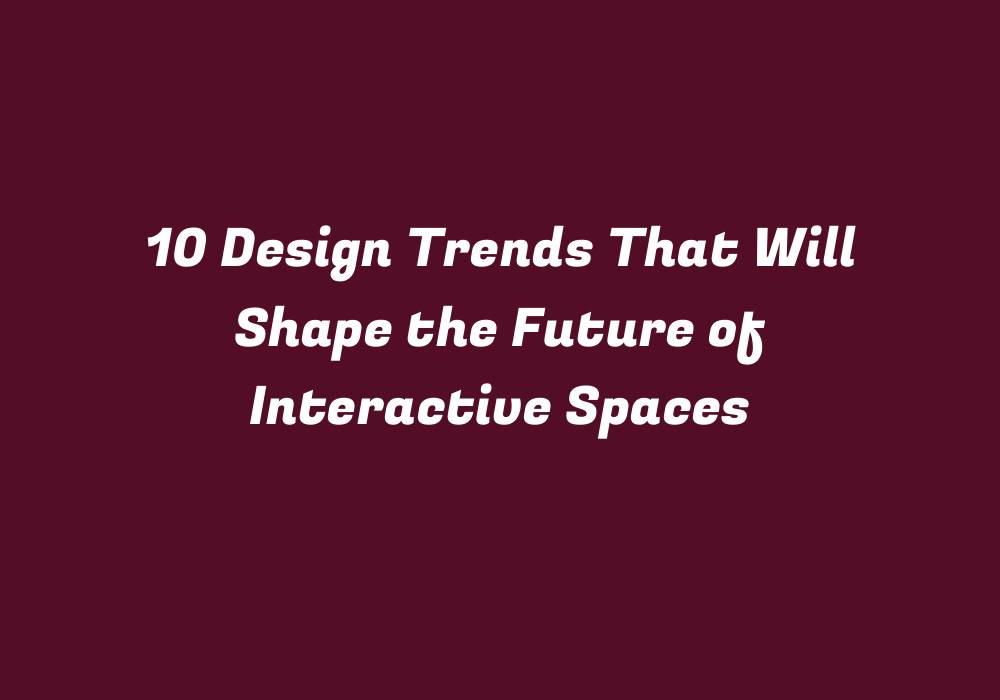10 Design Trends That Will Shape the Future of Interactive Spaces
Introduction
Interactive spaces are constantly evolving and adapting to our needs. From physical environments to digital realms, these spaces aim to engage users by allowing them to interact, participate, and create memorable experiences. As we venture into a future where technology is becoming increasingly intertwined with every aspect of life, certain design trends will stand out and shape the way people connect in interactive spaces.
1. The Rise of Augmented Reality (AR)
Augmented reality technology allows digital elements to be overlaid on real-world environments, enhancing our perception of the world around us. With AR now becoming more accessible, it is poised to revolutionize how users engage with interactive spaces. In museums and art galleries, for example, visitors can use AR apps to learn about historical artworks or view additional content related to specific pieces.
2. Virtual Reality (VR) Beyond Gaming
While VR has primarily been associated with gaming thus far, its applications are expanding rapidly. In the future, we will witness an increased presence of VR technology in various industries, from education and healthcare to architecture and design. Architects can now use VR for immersive walkthroughs of their designs, while surgeons can practice complex surgical procedures virtually before entering the operating room.
3. Gesture-Controlled Interfaces
Interactive spaces will become even more user-friendly with gesture-controlled interfaces. These systems allow users to interact without using physical devices, such as keyboards or mice, by utilizing body movements and hand gestures to control the interaction. This not only enhances accessibility for people with disabilities but also creates a more natural and immersive experience for everyone.
4. Sensor-Enabled Spaces
Smart sensors will play a vital role in shaping interactive spaces, monitoring ambient conditions like temperature, humidity, and air quality. These data points can be used to adapt the environment according to users’ needs or preferences. For instance, smart sensors could adjust the lighting and temperature based on individuals’ proximity, enhancing their overall comfort and engagement with the space.
5. Integrated Internet of Things (IoT) Systems
The Internet of Things (IoT) is a network of physical objects connected through the internet, allowing these devices to collect data and communicate with each other. In interactive spaces, IoT systems can be integrated into various devices for seamless interaction. This includes smartphones and wearables that can interact with the environment, providing users with a more personalized experience tailored to their preferences and activities.
6. Human-Centered Design (HCD) Approach
As technology continues to advance, it is essential to remember that humans are at the center of all interactions in interactive spaces. A human-centered design approach focuses on understanding users’ needs, goals, and experiences to create more intuitive and user-friendly interfaces. By putting people first, interactive spaces will foster better connections between individuals, technology, and their environment.
7. Experiential Design
Interactive spaces will place a greater emphasis on experiential design in the future, focusing on creating engaging and memorable experiences for users. This can be achieved through incorporating elements such as immersive storytelling, interactive installations, and innovative designs that evoke emotion and inspire users to participate more actively within these spaces.
8. Personalized Interactions
In an era of big data and predictive analytics, users will expect personalized experiences in their interactions with interactive spaces. Through the integration of artificial intelligence (AI), these spaces will be able to analyze user behaviors, preferences, and patterns to customize content and recommendations for each individual user. This tailored approach ensures that every visitor has a unique experience, making them more likely to engage and return to the space.
9. Flexible Spaces
Interactive spaces are adapting to become more flexible, enabling users to reconfigure them according to their needs or interests. Modular furniture, movable walls, and adaptive lighting systems are just some examples of design elements that can transform an interactive space from one purpose to another, catering to diverse groups and activities.
10. Sustainable Design Practices
As environmental concerns continue to grow, sustainable design practices will play a vital role in shaping the future of interactive spaces. These principles focus on designing with energy efficiency, material conservation, and resource optimization in mind. Interactive spaces that adopt sustainable methods not only reduce their carbon footprint but also create engaging experiences that inspire others to adopt similar practices in their own lives.
Conclusion
The future of interactive spaces promises a fusion of technology, design, and human-centered approaches, offering users more immersive, personalized, and adaptable environments. As we navigate this ever-evolving landscape, it is essential to keep an eye on the emerging trends that will continue to shape the way people interact, communicate, and create together in these innovative spaces.
